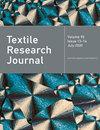纺织品再循环和回收:从生态友好的角度看纺织和服装行业面临的挑战
IF 1.9
4区 工程技术
Q2 MATERIALS SCIENCE, TEXTILES
引用次数: 0
摘要
由于全球人口的增长和生活条件的改善,再加上纺织产品生命周期的缩短,全球面临着日益严重的纺织品废弃物危机。纺织品回收利用是减少时尚和纺织行业产生的大量废物问题的关键环节之一。尽管有必要发展纺织废物回收产业,但仍需采取可接受的实用临时措施。纺织废物会对人们的生活造成经济和环境影响。利用天然或合成原料生产服装的每个阶段都会产生污染物和废物。在这篇综述文章中,我们从经济和环境的角度研究了时装和纺织业的影响。文章研究了各阶段废物回收和循环利用的现有技术和方法,并系统地调查了循环利用后产品的用途。尽管在时装业的废物回收过程中取得了诸多进展,但仍有许多不足和挑战需要解决。其中最关键的挑战是产业规模庞大、废料的收集和分类问题以及混合物和化学品等污染物的存在。此外,还需要提高消费者对纤维到纤维回收工艺重要性的认识,因为迄今为止,这一领域的进展与其必要性不成比例。总之,这篇文章对于任何有兴趣了解纺织、服装和时尚行业循环利用和回收现状的人来说,都是一份宝贵的资料。本文章由计算机程序翻译,如有差异,请以英文原文为准。
Textile Recycling and Recovery: An Eco-friendly Perspective on Textile and Garment Industries Challenges
The world has been facing a growing crisis in textile waste due to global population growth and improved living conditions, combined with a decrease in the life cycles of textile products. Textile recycling is one of the key aspects for reducing the massive waste problem generated by the fashion and textile industries. Despite the need to develop textile waste recycling industries, acceptable practical interim measures still need to be taken. Textile waste can affect people’s lives economically and environmentally. Producing apparel from natural or synthetic origin can produce pollutants and waste at each stage. In this review article, the effects of the fashion and textile industry have been studied from economic and environmental perspectives. The available technologies and methods for waste recovery and recycling at each stage have been studied, and the uses of products after recycling have been systematically investigated. Despite all the progress made in the waste recycling processes of the fashion industry, many deficiencies and challenges still need to be addressed. Among the most critical challenges are the large scale of industries, the problems of collecting and classifying waste materials, and the presence of contaminants including blends and chemicals. There is also need for more awareness among consumers about the importance of fiber-to-fiber recycling processes, because to date the progress in this field is out of proportion to its necessity. Overall, this article is a valuable resource for anyone interested in understanding the current state of recycling and recovery in the textiles, garment, and fashion industries.
求助全文
通过发布文献求助,成功后即可免费获取论文全文。
去求助
来源期刊

Textile Research Journal
工程技术-材料科学:纺织
CiteScore
4.00
自引率
21.70%
发文量
309
审稿时长
1.5 months
期刊介绍:
The Textile Research Journal is the leading peer reviewed Journal for textile research. It is devoted to the dissemination of fundamental, theoretical and applied scientific knowledge in materials, chemistry, manufacture and system sciences related to fibers, fibrous assemblies and textiles. The Journal serves authors and subscribers worldwide, and it is selective in accepting contributions on the basis of merit, novelty and originality.
 求助内容:
求助内容: 应助结果提醒方式:
应助结果提醒方式:


